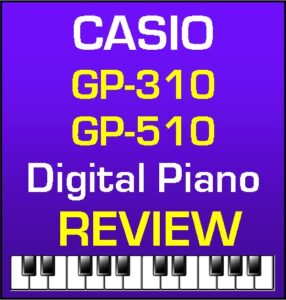 Casio GP-310, GP-510 | UPDATED REVIEW & Comparison | Feb 1, 2024 | Casio Grand Hybrid Digital Pianos | The new Casio Grand Hybrid models are the only digital pianos under $6300 price with the longest piano wooden keys constructed in Germany along with “moving” simulated grand piano style hammers from the famous Bechstein Grand Piano company of Germany.
Casio GP-310, GP-510 | UPDATED REVIEW & Comparison | Feb 1, 2024 | Casio Grand Hybrid Digital Pianos | The new Casio Grand Hybrid models are the only digital pianos under $6300 price with the longest piano wooden keys constructed in Germany along with “moving” simulated grand piano style hammers from the famous Bechstein Grand Piano company of Germany.Casio continues their 500 and 300 series of Grand Hybrid digital pianos with the GP-510 and GP-310 in 2024 which are the replacements for the previous discontinued models GP-500 and GP-300. The Grand Hybrid line includes just these 2 models. These hybrid piano models are the first 2 serious digital pianos for Casio developed in a joint venture by Casio and the famous Bechstein grand piano of Germany.
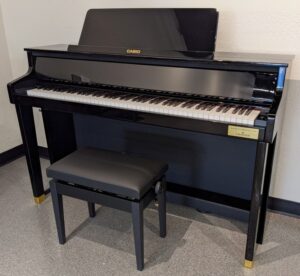 The newer Grand Hybrid pianos can be played by serious professional pianists who play at very high skill levels and these two models rival the top digital pianos being put out these days by the more famous piano companies including Yamaha and Kawai with their CLP and CA series.If you have thought in the past that Casio does not have what it takes to put out a top competitive digital piano in the higher price ranges because they have been more closely associated with “cheaper price” digital pianos, then think again…because in my opinion they have come up with a couple of very impressive pianos that even pro pianists can and do enjoy.
The newer Grand Hybrid pianos can be played by serious professional pianists who play at very high skill levels and these two models rival the top digital pianos being put out these days by the more famous piano companies including Yamaha and Kawai with their CLP and CA series.If you have thought in the past that Casio does not have what it takes to put out a top competitive digital piano in the higher price ranges because they have been more closely associated with “cheaper price” digital pianos, then think again…because in my opinion they have come up with a couple of very impressive pianos that even pro pianists can and do enjoy.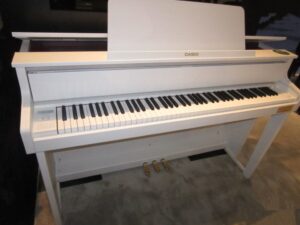 I am a long time pianist and piano teacher and I try to play every new digital piano that comes out on the market regardless of whether I already like that brand or not. There are some brands known for poorly designed digital pianos, others are known for cheap price digital pianos, and still other brands are known for being pro quality instruments that top pianists, music teachers, and other advanced players (like me) enjoy playing. So when it came to trying out and playing the Casio Grand Hybrid GP-310 and GP-510 with a price of $4299 and $6299 respectively, I was skeptical that they could be as good as Casio claimed they were because most people don’t think of the Casio company competing in this higher price range with Yamaha, Kawai, Roland, etc.
I am a long time pianist and piano teacher and I try to play every new digital piano that comes out on the market regardless of whether I already like that brand or not. There are some brands known for poorly designed digital pianos, others are known for cheap price digital pianos, and still other brands are known for being pro quality instruments that top pianists, music teachers, and other advanced players (like me) enjoy playing. So when it came to trying out and playing the Casio Grand Hybrid GP-310 and GP-510 with a price of $4299 and $6299 respectively, I was skeptical that they could be as good as Casio claimed they were because most people don’t think of the Casio company competing in this higher price range with Yamaha, Kawai, Roland, etc.I have done many reviews on those lower priced Casio models under $4000 and Casio is a leader in that price range. But a Casio for about $4300 and upwards to over $6000?…I thought there is just no way they could compete in that space. But was I ever wrong about that! They now definitely offer a very impressive piano playing experience that’s hard to find in this price range, and in fact they offer more piano playing realism in some ways than the more well known name brands in this price range, and for less money too. Think you should not consider one of these new Casio Grand Hybrid digital pianos…then I suggest you ought to “think again” because you may be surprised at what you find from these 2 Grand Hybrid models built in collaboration with the Bechstein grand piano company of Germany.
*As you keep reading this review do not miss watching the two videos I have posted at the bottom of this review. Also you can click on any pictures for larger views.

Bechstein pianos had become the norm in many concert halls and private
mansions.
 By that time three piano makers, all of which were founded in 1853, became established as the industry leaders across the world and they were Bechstein, Blüthner and Steinway & Sons. So the Bechstein brand was in very good company:). In 1881 Bechstein began supplying pianos to Queen Victoria and a gilded art-case piano was delivered to Buckingham Palace followed by several more Bechstein pianos to Windsor Castle and other royal residences. By January 1886 they were among the piano manufacturers holding was called “a Royal Warrant” as a supplier to the Queen. Several British embassies across the world acquired Bechstein pianos and they are still popular across the world today and used by professional pianists in concert. However, that brand is not as well known in America as they are in Europe and other parts of the world.
By that time three piano makers, all of which were founded in 1853, became established as the industry leaders across the world and they were Bechstein, Blüthner and Steinway & Sons. So the Bechstein brand was in very good company:). In 1881 Bechstein began supplying pianos to Queen Victoria and a gilded art-case piano was delivered to Buckingham Palace followed by several more Bechstein pianos to Windsor Castle and other royal residences. By January 1886 they were among the piano manufacturers holding was called “a Royal Warrant” as a supplier to the Queen. Several British embassies across the world acquired Bechstein pianos and they are still popular across the world today and used by professional pianists in concert. However, that brand is not as well known in America as they are in Europe and other parts of the world.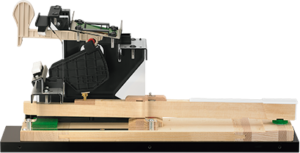
What this all means is that the wood key action movement in the Casio Grand Hybrid pianos is directly from the Bechstein piano company and built for the new Casio GP piano series and the keys themselves are authentic full size grand piano keys made from real spruce-wood from individual spruce trees in Austria (wow, that’s pretty cool!). From what I have learned, the natural wood is precision cut and aged slowly over the time so that the keys in the key action can remain solid, aligned, and playable over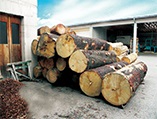 years of practice and performance. Attached to the wood key action inside these Grand Hybrid models is a moving hammer mechanism designed to imitate real hammers in an acoustic grand piano.
years of practice and performance. Attached to the wood key action inside these Grand Hybrid models is a moving hammer mechanism designed to imitate real hammers in an acoustic grand piano.
This moving hammer mechanism is made from resin and synthetic compounds, etc that can withstand weather and humidity changes so that the hammers will last almost indefinitely without the need for adjustment or maintenance as you would otherwise have in a real acoustic piano. When the hammers move as you are pressing a key, you can actually feel the weight of those keys under your fingers and direct connection of the moving hammer mechanism inside the piano as counterweights to the keys which gives the player a feeling of natural expression and being directly connected to the music in a way that digital pianos without moving full length hammers cannot really do.
The hammers in the Grand Hybrid pianos don’t actually strike any strings in the piano because there are no strings (the piano sound is digitally reproduced)…and that’s one of the positive aspects of a digital piano…no strings to tune and maintain which otherwise can be very costly over many years.
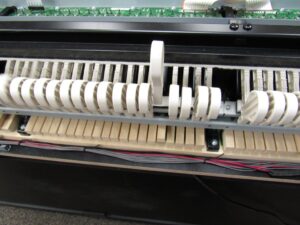 When I played both the GP-310 and GP-510 for long periods of time, it was like I was actually playing a real grand piano in many ways and the feeling was pretty amazing for a digital piano. I will say that this key action does not feel “exactly” like a real full size acoustic grand piano because that type of thing would require a real full size acoustic grand piano key action. I should know because I play full size acoustic grand pianos from Steinway, Bosendorfer, Yamaha, Kawai, and others. The Grand Hybrid pianos have a “simulated” grand piano key action but for most people this Bechstein Grand Hybrid key action will very enjoyable to play and give you the feeling that you are playing the real thing. One of the reasons for this is because the action has extra long keys (aka: key sticks) inside the piano and the balance points of the action are well done.
When I played both the GP-310 and GP-510 for long periods of time, it was like I was actually playing a real grand piano in many ways and the feeling was pretty amazing for a digital piano. I will say that this key action does not feel “exactly” like a real full size acoustic grand piano because that type of thing would require a real full size acoustic grand piano key action. I should know because I play full size acoustic grand pianos from Steinway, Bosendorfer, Yamaha, Kawai, and others. The Grand Hybrid pianos have a “simulated” grand piano key action but for most people this Bechstein Grand Hybrid key action will very enjoyable to play and give you the feeling that you are playing the real thing. One of the reasons for this is because the action has extra long keys (aka: key sticks) inside the piano and the balance points of the action are well done.
 This extra long key allows the key action to feel and play more like a grand piano because full grand pianos have much longer wooden white (and black) keys that measure typically around 20″ long (and longer) for white keys in regular acoustic grand pianos, and that’s a very long key stick.There is no other hybrid digital piano with 16″ long keys or more until you get to a Yamaha hybrid digital grand piano key action series and those models start at $9800 and go up from there. Just because this is a “digital piano” does not mean you won’t get a very satisfying key action playing experience in this lower price range $4299 to $6299.
This extra long key allows the key action to feel and play more like a grand piano because full grand pianos have much longer wooden white (and black) keys that measure typically around 20″ long (and longer) for white keys in regular acoustic grand pianos, and that’s a very long key stick.There is no other hybrid digital piano with 16″ long keys or more until you get to a Yamaha hybrid digital grand piano key action series and those models start at $9800 and go up from there. Just because this is a “digital piano” does not mean you won’t get a very satisfying key action playing experience in this lower price range $4299 to $6299.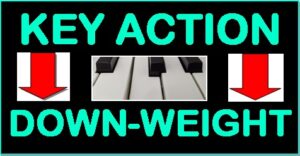 The down-weight and up-weight of the keys are also very impressive weighing in at just about 63 grams of down-weight force needed to press down a middle C. white key as compared to a real concert grand piano down-weight force (measured at middle C.The middle C# key touch-weight measures at approx 70 grams so that’s just slightly heavier than the white keys which is fine. On a real top name high quality acoustic grand piano, the touch weight force generally measures at somewhere between 50 to 65 grams for both the white and black keys.
The down-weight and up-weight of the keys are also very impressive weighing in at just about 63 grams of down-weight force needed to press down a middle C. white key as compared to a real concert grand piano down-weight force (measured at middle C.The middle C# key touch-weight measures at approx 70 grams so that’s just slightly heavier than the white keys which is fine. On a real top name high quality acoustic grand piano, the touch weight force generally measures at somewhere between 50 to 65 grams for both the white and black keys.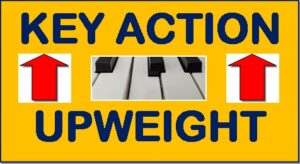 Most digital piano black keys tend to have a much larger difference in weight as compared to the white keys where those black keys can be substantially heavier or lighter than the white keys. In this case the black key on the GP-310/510 is fairly close in down-weight and also up-weight as compared to the white key, so that’s good.The return force (aka: upweight) of the white key on middle C measures at about 35 grams of up-force which is also very good. The upweight return force on middle C# is at about 40 grams which is also good and appropriate for the black key given its slightly heavier down-weight touch as compared to the middle C white key. Hopefully all that jargon will make some sense to you.
Most digital piano black keys tend to have a much larger difference in weight as compared to the white keys where those black keys can be substantially heavier or lighter than the white keys. In this case the black key on the GP-310/510 is fairly close in down-weight and also up-weight as compared to the white key, so that’s good.The return force (aka: upweight) of the white key on middle C measures at about 35 grams of up-force which is also very good. The upweight return force on middle C# is at about 40 grams which is also good and appropriate for the black key given its slightly heavier down-weight touch as compared to the middle C white key. Hopefully all that jargon will make some sense to you.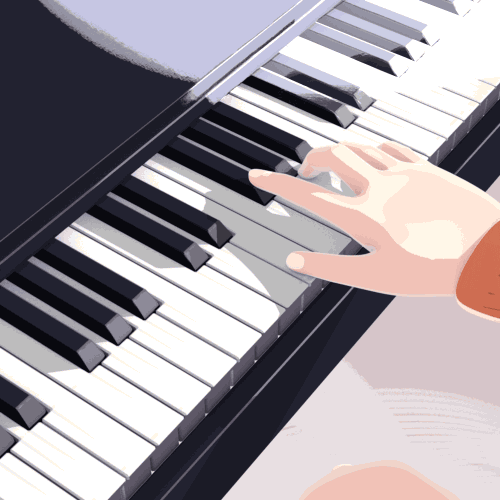 The key weight force is also even from the front of the keys to the back of the keys. This type of key balance is the way more advanced players will want to have it.Upright acoustic pianos have noticeably different key weight on the same key as your fingers go from playing near the front of the key to the back of the key. Upright pianos are noticeably different than grand pianos in that way and that’s one of the reasons why you will never see an advanced player play an upright piano on stage…it’s because it will alter and limit your playing technique.
The key weight force is also even from the front of the keys to the back of the keys. This type of key balance is the way more advanced players will want to have it.Upright acoustic pianos have noticeably different key weight on the same key as your fingers go from playing near the front of the key to the back of the key. Upright pianos are noticeably different than grand pianos in that way and that’s one of the reasons why you will never see an advanced player play an upright piano on stage…it’s because it will alter and limit your playing technique.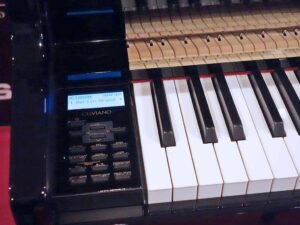 The key action feels smooth, balanced, easy and responsive to play without being too firm or too light. So the overall playing experience in my opinion is more like playing a natural grand piano than nearly all of the other digital piano brands in this price range in this price range, and I have had other advanced piano players tell me that as well. It is interesting to note that this Bechstein GP key action does not have the notched escapement/let-off feel that you would normally experience and associate with playing a real grand piano when playing the keys very lightly and softly, but there is a reason for this. I was told that the Bechstein company wanted the fastest responding acoustic piano style action that was possible to get in a digital piano.
The key action feels smooth, balanced, easy and responsive to play without being too firm or too light. So the overall playing experience in my opinion is more like playing a natural grand piano than nearly all of the other digital piano brands in this price range in this price range, and I have had other advanced piano players tell me that as well. It is interesting to note that this Bechstein GP key action does not have the notched escapement/let-off feel that you would normally experience and associate with playing a real grand piano when playing the keys very lightly and softly, but there is a reason for this. I was told that the Bechstein company wanted the fastest responding acoustic piano style action that was possible to get in a digital piano.
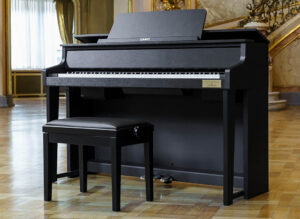 Many of the new name brand digital pianos are using synthetic ivory feel white key tops with the purpose of trying to recreate the feel of older grand pianos from the 1960’s and earlier years when real ivory was the material used to create the key tops. However, for many years now, real acoustic grand pianos have not had real or synthetic ivory on their keys so the keytop feel of the new Grand Hybrid pianos is identical to what current day acoustic grand pianos feel like. In this way you can transition from a real acoustic grand or upright piano to a Casio/Bechstein Celviano Hybrid GP-310 or GP-510 digital piano with no differences at all in the key “feel” and materials used on the keys. The black keys are a natural satin finish made of phenol so that feel will also be the same as an acoustic grand piano.
Many of the new name brand digital pianos are using synthetic ivory feel white key tops with the purpose of trying to recreate the feel of older grand pianos from the 1960’s and earlier years when real ivory was the material used to create the key tops. However, for many years now, real acoustic grand pianos have not had real or synthetic ivory on their keys so the keytop feel of the new Grand Hybrid pianos is identical to what current day acoustic grand pianos feel like. In this way you can transition from a real acoustic grand or upright piano to a Casio/Bechstein Celviano Hybrid GP-310 or GP-510 digital piano with no differences at all in the key “feel” and materials used on the keys. The black keys are a natural satin finish made of phenol so that feel will also be the same as an acoustic grand piano. Oh, and one other important thing that I should mention: the there is virtually no noise coming from the key action when the keys are moving up & down. In other words, the keys are very quiet when moving up & down, especially as compared to other key actions in this price range which can have a more noticeable ambient noise coming from the keys when those keys are moving up & down. When keys move down they can make a lot of noise when touching bottom and when the keys come back up and return to resting position then some digital piano key actions can make a lot of “return noise” in that way. The Bechstein made key actions are exceptionally quiet and this is even more evident when using headphones and other people in the room can hear the keys move and that’s when noise is also more of a factor. Hat’s off the Bechstein for producing a very quiet playing key action.
Oh, and one other important thing that I should mention: the there is virtually no noise coming from the key action when the keys are moving up & down. In other words, the keys are very quiet when moving up & down, especially as compared to other key actions in this price range which can have a more noticeable ambient noise coming from the keys when those keys are moving up & down. When keys move down they can make a lot of noise when touching bottom and when the keys come back up and return to resting position then some digital piano key actions can make a lot of “return noise” in that way. The Bechstein made key actions are exceptionally quiet and this is even more evident when using headphones and other people in the room can hear the keys move and that’s when noise is also more of a factor. Hat’s off the Bechstein for producing a very quiet playing key action.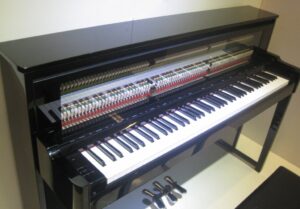 As a reference and comparison, the only other top name pianos with actual moving piano hammers in a digital piano is the Yamaha Avant Grand series of digital pianos including the NU1X, N1X, N2, and N3X as well as the Kawai NV5S upright and NV10S with grand piano action. However, these pianos all use wood hammers, wood hammer shanks, and wooden organic connective parts which are very good and just like an acoustic piano but will likely require more maintenance over time. As an example, the Yamaha NU1X (left pic – see-through front is for display purposes only) upright style piano sells for $7400 at local store discount price and it has an upright console hammer key action but not a grand piano key action, and there is a very big difference between the two types. Beyond that, the NU1X has very few sounds and very few digital options and features so it’s a very, basic digital piano in that way, although the cabinet is attractive in its polished ebony finish.
As a reference and comparison, the only other top name pianos with actual moving piano hammers in a digital piano is the Yamaha Avant Grand series of digital pianos including the NU1X, N1X, N2, and N3X as well as the Kawai NV5S upright and NV10S with grand piano action. However, these pianos all use wood hammers, wood hammer shanks, and wooden organic connective parts which are very good and just like an acoustic piano but will likely require more maintenance over time. As an example, the Yamaha NU1X (left pic – see-through front is for display purposes only) upright style piano sells for $7400 at local store discount price and it has an upright console hammer key action but not a grand piano key action, and there is a very big difference between the two types. Beyond that, the NU1X has very few sounds and very few digital options and features so it’s a very, basic digital piano in that way, although the cabinet is attractive in its polished ebony finish.
The higher priced Yamaha N1X ($9,800 discount price) has a grand piano style action (as I mentioned earlier) with all wood parts, but would likely require more maintenance over time as I mentioned earlier. The Yamaha N1X AvantGrand is an exceptionally nice digital piano but is still quite a 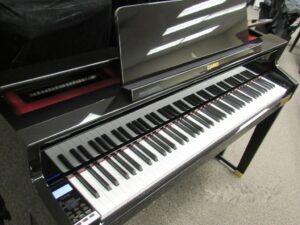 bit more money than the Casio GP-310 and GP-510. The Yamaha N2 and N3X go way up in price from the N1X and all have the same key actions as the N1X and pretty much the same basic features with a few exceptions.
bit more money than the Casio GP-310 and GP-510. The Yamaha N2 and N3X go way up in price from the N1X and all have the same key actions as the N1X and pretty much the same basic features with a few exceptions.
So when it comes to a key action mechanism in a digital piano, this new Casio Celviano Grand Hybrid GP-310 and GP-510 (GP-510 in polished ebony, above left pic) in my opinion is ahead of the Yamaha upright NU1X in a number of ways and somewhat competitive to the higher priced Yamaha AvantGrand N1X, N2, and N3X pianos, although the Yamaha N series Grand Key actions are the “real deal” and more organic and natural as compared to the Casio’s…but they should be given their much higher prices.

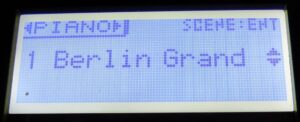
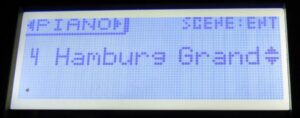 The GP-510 and GP-310 have the industry standard 256-note polyphony processing power which is important in helping to give the player enough power to play more complex pieces of music without the loss of notes or damper sustain. As far as piano sound authenticity goes, all of the major digital piano companies would claim to have the best piano sound in their digital pianos and certainly Casio is no exception. What else would you expect them to say?! Casio wants you to believe they have the best piano sound found in these new hybrid digital pianos and overall I believe they have done a very good job and I was impressed.
The GP-510 and GP-310 have the industry standard 256-note polyphony processing power which is important in helping to give the player enough power to play more complex pieces of music without the loss of notes or damper sustain. As far as piano sound authenticity goes, all of the major digital piano companies would claim to have the best piano sound in their digital pianos and certainly Casio is no exception. What else would you expect them to say?! Casio wants you to believe they have the best piano sound found in these new hybrid digital pianos and overall I believe they have done a very good job and I was impressed.
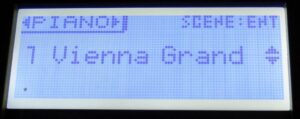 Since the Casio GP series is designed in cooperation with the Bechstein piano company of Germany, it is easy to understand why the three main piano sounds in the GP series are so good. I found each piano sound sample to be unique with their own qualities of tone and dynamic range, but yet they were all enjoyable to play. What did impress me most about the piano sounds were their dynamic range of tone and the ability to really express yourself across all tonal ranges depending on your touch and finger movement.
Since the Casio GP series is designed in cooperation with the Bechstein piano company of Germany, it is easy to understand why the three main piano sounds in the GP series are so good. I found each piano sound sample to be unique with their own qualities of tone and dynamic range, but yet they were all enjoyable to play. What did impress me most about the piano sounds were their dynamic range of tone and the ability to really express yourself across all tonal ranges depending on your touch and finger movement.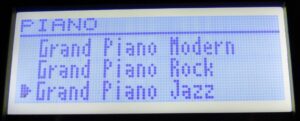
The German Bechstein sound was also impressive to me and more natural and realistic in a delicate way than many of the competitive brands, especially the new Roland LX series digital pianos. In my opinion the Casio Grand Hybrid piano sounds are noticeably more natural, more organic, have a wider dynamic tonal range, and just give you the feeling that you are not playing a digital piano.
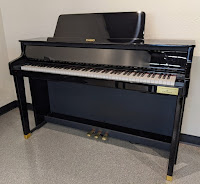 With 256-note polyphony processing power along with very good pedal sustain/decay time and dynamic expression, even advanced classical music can be played well including the layering of two instrument sounds together. Since there is a $2000 difference in price between the GP-510 and GP-310, then you would think there must be important differences between those 2 models and you would be right. With regard to the all important “acoustic piano sound” in these 2 digital piano models, the GP-510 sounds more realistic as compared to the GP-310 in terms of tonal richness, clarity, and presence of the 3 stereo piano sounds. But it should given the big price difference.
With 256-note polyphony processing power along with very good pedal sustain/decay time and dynamic expression, even advanced classical music can be played well including the layering of two instrument sounds together. Since there is a $2000 difference in price between the GP-510 and GP-310, then you would think there must be important differences between those 2 models and you would be right. With regard to the all important “acoustic piano sound” in these 2 digital piano models, the GP-510 sounds more realistic as compared to the GP-310 in terms of tonal richness, clarity, and presence of the 3 stereo piano sounds. But it should given the big price difference.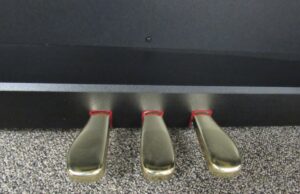 Pedaling is always important to the piano playing experience and the Grand Hybrids will likely not disappoint you since it is done the traditional way with damper pedal including continuous detection pedaling along with adjustable half-damper control, sostenuto pedal, and soft pedal. The pedals seem to move naturally and they have a type of grand feel movement to the pedals unlike some other digital pianos I have played that have lightweight movement or no half-damper pedal control. Casio also added pedal resonance and damper noise to simulate what real acoustic pianos do when using the damper pedal for sustaining the piano tones. So the pedaling portion of this model is convincing, at least it is to me and I played it quite a bit.
Pedaling is always important to the piano playing experience and the Grand Hybrids will likely not disappoint you since it is done the traditional way with damper pedal including continuous detection pedaling along with adjustable half-damper control, sostenuto pedal, and soft pedal. The pedals seem to move naturally and they have a type of grand feel movement to the pedals unlike some other digital pianos I have played that have lightweight movement or no half-damper pedal control. Casio also added pedal resonance and damper noise to simulate what real acoustic pianos do when using the damper pedal for sustaining the piano tones. So the pedaling portion of this model is convincing, at least it is to me and I played it quite a bit.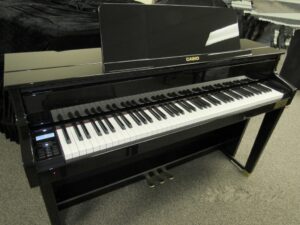
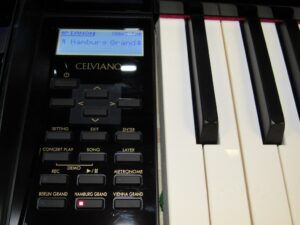 As far as the operating system goes, Casio incorporated a side panel control unit with LCD display which is very similar to what Kawai and Yamaha are currently using in their digital pianos. Although this is a simple and elegant design created to reduce the “digital look” of the buttons and controls of the piano and make it more minimalistic, I would prefer an attached lid or cover on that panel so you wouldn’t see it at all when the piano is not in use or you just don’t want to change controls while playing and don’t want to see the panel. Regardless, the control panel still looks good, is minimal in design, and I found that using the controls was fairly easy to do (although there is still a small learning curve) and the display screen was, overall, easy to read and buttons were easy to use.
As far as the operating system goes, Casio incorporated a side panel control unit with LCD display which is very similar to what Kawai and Yamaha are currently using in their digital pianos. Although this is a simple and elegant design created to reduce the “digital look” of the buttons and controls of the piano and make it more minimalistic, I would prefer an attached lid or cover on that panel so you wouldn’t see it at all when the piano is not in use or you just don’t want to change controls while playing and don’t want to see the panel. Regardless, the control panel still looks good, is minimal in design, and I found that using the controls was fairly easy to do (although there is still a small learning curve) and the display screen was, overall, easy to read and buttons were easy to use.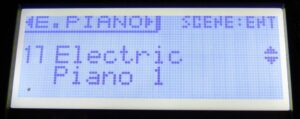
The feature set and sound library in the higher priced GP-510 includes 35 instrument sounds (the GP-310 has 28 sounds) which include acoustic pianos, strings, choirs, organs, harpsichords, etc. Theses sounds can be layered 2 at a time, split with 2 different instruments one on the left side and one on the right side, duet piano mode for 2-person simultaneous play, registration preset “scene” mode for saving your own setups or using preset factory setups for instant play, lots of different hall/reverb settings which really adds to the realism of the piano sound along with adjustable touch sensitivity, brilliance, and DSP which helps the user/player create a customizable piano sound and action response. There are a number of specific organic piano sound elements which Casio/Bechstein incorporates into the GP-510 which allows the piano sounds to be even more natural and organic.
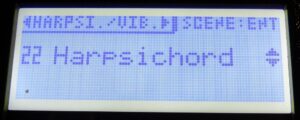
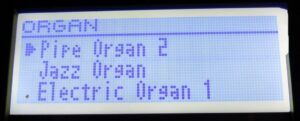 This feature is called the “Acoustic Simulator” and would include things like adjustable Hammer Response, Damper Resonance, String Resonance, Aliquot Resonance (this feature is found in fine grand pianos and adds to the harmonic richness and clarity of the piano sound), Open String Resonance, Lid Simulator, Key Off Simulator, Damper Noise, Key On Action
This feature is called the “Acoustic Simulator” and would include things like adjustable Hammer Response, Damper Resonance, String Resonance, Aliquot Resonance (this feature is found in fine grand pianos and adds to the harmonic richness and clarity of the piano sound), Open String Resonance, Lid Simulator, Key Off Simulator, Damper Noise, Key On Action
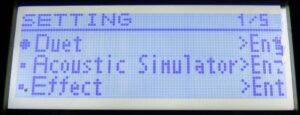 Noise, and Key Off Action Noise all of which are adjustable so that you can micro -customize the piano tones the way it would sound best to you. The GP’s also have a variety of tuning temperaments as well as a variety of piano stretch tunings including being able to shut off the stretch tuning depending on what sounds best to you. But for many people the factory default preset acoustic piano sounds may likely be enough to give you an outstanding piano playing experience.
Noise, and Key Off Action Noise all of which are adjustable so that you can micro -customize the piano tones the way it would sound best to you. The GP’s also have a variety of tuning temperaments as well as a variety of piano stretch tunings including being able to shut off the stretch tuning depending on what sounds best to you. But for many people the factory default preset acoustic piano sounds may likely be enough to give you an outstanding piano playing experience.When it comes to adding some “fun” to this model, Casio has a new feature called “Concert Play” which means that you can select from up to 15 songs that are full orchestral CD quality renditions of famous classical music that you can listen to and play along with. You can even slow down the concert song while you try to learn it as well as rewind, fast forward, and loop a set of measures together for repeat play.
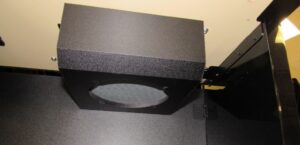 The 2 main, larger speakers of the piano (which I have found to be very high quality) are housed in separate acoustic boxes mounted underneath the piano with the speakers facing downward rather than forward as on some other digital pianos.This design allows the GP piano sound to come both towards the player on the top and the bigger speakers towards the floor like a grand piano soundboard would do. In my opinion this makes for a more natural piano sound experience and I did like it very much. In fact, if you turn up the master volume control to about 3/4 volume to full volume, that volume will fill up a huge room and even be overpowering. So when comparing the 100 watt specs in the Grand Hybrid pianos to other digital pianos out there which “spec out” with more wattage, don’t let that make you think the Casio doesn’t have “enough” power. The Casio GP-310 and GP-510 will blow your windows out if you want them to:)
The 2 main, larger speakers of the piano (which I have found to be very high quality) are housed in separate acoustic boxes mounted underneath the piano with the speakers facing downward rather than forward as on some other digital pianos.This design allows the GP piano sound to come both towards the player on the top and the bigger speakers towards the floor like a grand piano soundboard would do. In my opinion this makes for a more natural piano sound experience and I did like it very much. In fact, if you turn up the master volume control to about 3/4 volume to full volume, that volume will fill up a huge room and even be overpowering. So when comparing the 100 watt specs in the Grand Hybrid pianos to other digital pianos out there which “spec out” with more wattage, don’t let that make you think the Casio doesn’t have “enough” power. The Casio GP-310 and GP-510 will blow your windows out if you want them to:)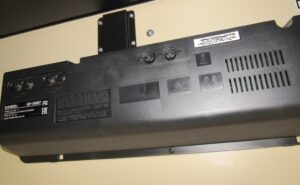 The piano also has 2 headphone jacks for private play along with USB output to device for iPad and computer connectivity and USB flashdrive input for song play and recording, and also two regular MIDI connectors for those people who have MIDI music gear that they want to connect to the piano. Casio included 1/4″ input and output audio jacks for connecting external devices to enhance the piano sound even further through external speakers or use the internal speaker system to amplify other sound devices such as computers, tablets, MP3 players, etc.
The piano also has 2 headphone jacks for private play along with USB output to device for iPad and computer connectivity and USB flashdrive input for song play and recording, and also two regular MIDI connectors for those people who have MIDI music gear that they want to connect to the piano. Casio included 1/4″ input and output audio jacks for connecting external devices to enhance the piano sound even further through external speakers or use the internal speaker system to amplify other sound devices such as computers, tablets, MP3 players, etc.
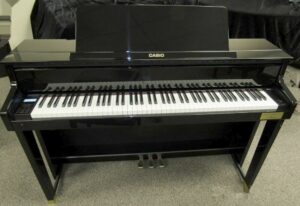
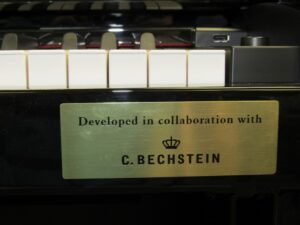 There are other functions and features on the GP-510 and GP-310 but those are secondary things as compared with what I believe it this digital piano’s primary purpose and goal…to offer an impressive grand piano playing experience in a beautiful polished ebony cabinet with folding key cover, full size music rack, opening lid and matching bench along with a complete 5 year factory warranty on manufacturer defects if they should ever occur. The GP-510 is only available in polished ebony finish, so if you want a non-polished ebony color, the GP-310 come in matte black as well as a very attractive matte white.
There are other functions and features on the GP-510 and GP-310 but those are secondary things as compared with what I believe it this digital piano’s primary purpose and goal…to offer an impressive grand piano playing experience in a beautiful polished ebony cabinet with folding key cover, full size music rack, opening lid and matching bench along with a complete 5 year factory warranty on manufacturer defects if they should ever occur. The GP-510 is only available in polished ebony finish, so if you want a non-polished ebony color, the GP-310 come in matte black as well as a very attractive matte white.
Based on what I have seen for many years on all of the other digital pianos that Casio has produced and the overall quality and “bang for the buck” they have brought to the table, I believe Casio has a great future in this premium category for higher priced digital pianos with the introduction of their upgraded Grand Hybrid series in cooperation with the Bechstein Piano Company.
![]() Casio has not, in the past, had the prestige or gravitas of a digital piano name like Yamaha, Kawai, or Roland. I know that, they know that, and many piano shoppers know that. But a name means somewhat less these days considering how much great technology is being developed by
Casio has not, in the past, had the prestige or gravitas of a digital piano name like Yamaha, Kawai, or Roland. I know that, they know that, and many piano shoppers know that. But a name means somewhat less these days considering how much great technology is being developed by
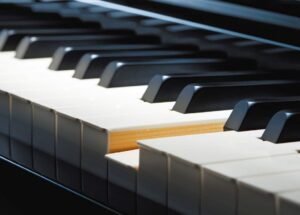 digital piano companies who were not as well known before with having higher priced premium piano products, such as these Grand Hybrid pianos. Even though Casio is very well known in the lower priced digital piano keyboard world, they were definitely not known for having digital pianos which compete with the highest price range for Kawai, Yamaha, or Roland digital pianos…but now they do so I believe the wait was worth it.
digital piano companies who were not as well known before with having higher priced premium piano products, such as these Grand Hybrid pianos. Even though Casio is very well known in the lower priced digital piano keyboard world, they were definitely not known for having digital pianos which compete with the highest price range for Kawai, Yamaha, or Roland digital pianos…but now they do so I believe the wait was worth it.
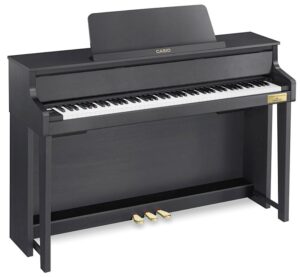 |
| GP-310 matte black |
As for the other Casio-Bechstein model GP-310 ($4299 price), the piano sound is very realistic with natural organic tonal elements including a full dynamic range of sound from very soft to very loud and in-between with smooth volume transitions. But the GP-510 goes beyond it with added “resonating tonal elements” to make it even more realistic & impressive but that model sells for $2000 more than the GP-310 so I would expect it to be better.
After putting the Grand Hybrid’s through their paces I agree that these models would make an excellent addition to anyone’s home, church, school, or studio as long as they understand that the Grand Hybrid digital pianos are primarily designed to be purchased in place of an acoustic grand piano and are not heavy on additional features so does not have wireless, Bluetooth, dozens of extra instrument sounds, drum patterns, automatic interactive chords, General MIDI recording or playback, multi-track sequencer, and no proprietary iPad apps like some other digital pianos do.
However, with USB to device connectivity you can plug in a USB cable and use many MIDI iPad apps with full MIDI/USB interaction from a Grand Hybrid to the iPad along with Bluetooth audio connectivity using a 3rd party Bluetooth adapter plugged into the piano audio input so that music from your iPad/Android device can stream directly through the GP-510 speaker system. Also, it has been my experience that direct connectivity using a USB cable is more stable than with internal Bluetooth connectivity.
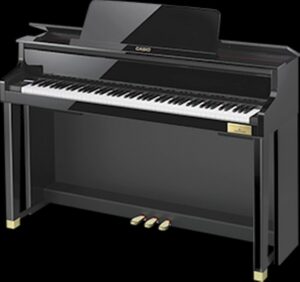 |
| GP-510 polished ebony |
As far as I am concerned, at 171 lbs in weight with cabinet dimensions of approximately 56″ x 19″x 38″ the very attractive matte finish GP-310 and polished ebony GP-510 are pianos I would definitely own if I wanted to focus squarely on the best possible grand piano playing experience that Casio-Bechstein has to offer along with being a more minimalistic looking instrument which adds to the overall elegance of these pianos. The Bechstein key action hammer system is not available in any brand of digital piano and you won’t get a moving grand piano hammer mechanism until you get to the Yamaha AvantGrand N1X which sell a price of $9,999.
The appearance of the GP-310 and GP-510 are also attractive in that when you prop open the lid of the piano to let the sound come out more, you see an attractive red material covering the inside piano top and you can actually see the moving piano hammers through two long rectangular windows in the top of the piano while you are playing the keys. It’s a very cool visual experience along with having a beautiful piece of furniture.
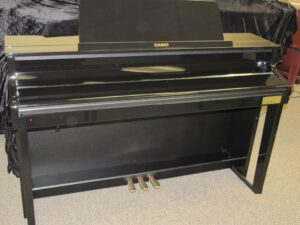 There is one thing I find to be a bit odd when it comes to the GP-510 and that is the height adjustable black bench included with the piano does not match the high gloss black piano finish. The bench is a single size satin black (non-gloss) finish and even though an adjustable height bench is very nice to have, I am a bit baffled by the lack of a matching high gloss finish on the bench. Is this an oversight on the part of Casio or what? I just don’t understand the reason for this but it’s something which can be easily corrected if Casio chooses to do that which I recommend that they do. The satin black bench is fine for their satin (matte) black pianos and it’s also ok for the GP510 high gloss model. But it would have been better for the GP-510 if the bench was high gloss as well.
There is one thing I find to be a bit odd when it comes to the GP-510 and that is the height adjustable black bench included with the piano does not match the high gloss black piano finish. The bench is a single size satin black (non-gloss) finish and even though an adjustable height bench is very nice to have, I am a bit baffled by the lack of a matching high gloss finish on the bench. Is this an oversight on the part of Casio or what? I just don’t understand the reason for this but it’s something which can be easily corrected if Casio chooses to do that which I recommend that they do. The satin black bench is fine for their satin (matte) black pianos and it’s also ok for the GP510 high gloss model. But it would have been better for the GP-510 if the bench was high gloss as well.
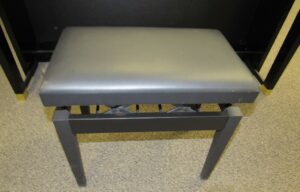 It’s also important to note that some very nice high gloss polished ebony benches are available on-line at Amazon.com for low prices around $75 on up.The extra cost for a polished ebony bench (should you feel you really need it) is a small price to pay. The bench issue is definitely not a deal breaker for me and is a small thing as compared with all of the great things this piano can do.
It’s also important to note that some very nice high gloss polished ebony benches are available on-line at Amazon.com for low prices around $75 on up.The extra cost for a polished ebony bench (should you feel you really need it) is a small price to pay. The bench issue is definitely not a deal breaker for me and is a small thing as compared with all of the great things this piano can do.
|
Features
|
GP-310
|
GP-510
|
Upgrades
|
|
Polyphony
|
256
|
256
|
|
|
Total sounds
|
26 incl strings, organs, harpsichord, etc
|
35 incl strings, organs, harpsichord, etc
|
New Harpsichord tone
|
|
Main piano sounds
|
Berlin,
Hamburg, Vienna |
Berlin,
Hamburg, Vienna |
Longer piano sustain/decay time
|
|
Total grand pianos
|
12
|
14
|
Better legato response
|
|
Grand hammer action
|
Yes
– individual keys |
Yes
– individual keys |
|
|
Full length grand keys
|
Acoustic
grand keys |
Acoustic
grand keys |
|
|
Graded-weighted keys
|
Yes,
medium weight |
Yes,
medium weight |
|
|
Austrian wooden keys
|
Aged
organic spruce |
Aged
organic Spruce |
|
|
Grand fulcrum point
|
Yes
|
Yes
|
|
|
Acrylic white keytops
|
Yes
– grand style |
Yes
– grand style |
|
|
Phenol black keytops
|
Yes
– grand style |
Yes
– grand style |
|
|
Key Center Pin
|
Yes
– grand style |
Yes
– grand style |
|
|
Grand hammers
|
Resin
– full movement |
Resin
– full movement |
|
|
Hardware
resonator |
No
|
Yes
– affects each key |
|
|
Triple key sensor
|
Yes
|
Yes
|
|
|
Key force detection
|
Yes
|
Yes
|
|
|
Hammer response
|
Yes
|
Yes
|
|
|
String resonance
|
Yes
|
Yes
|
|
|
Lid simulator system
|
Yes
|
Yes
|
|
|
Open string resonance
|
No
|
Yes
|
|
|
Aliquot resonance
|
No
|
Yes
|
|
|
Key on action noise
|
Yes
|
Yes
|
added to GP-310
|
|
Key off action noise
|
Yes
|
Yes
|
added to GP-310
|
|
Brilliance control
|
Yes
|
Yes
|
|
|
Hall-reverb simulator
|
Yes
– 12 types |
Yes
– 12 types |
|
|
DSP & chorus effects
|
Yes
|
Yes
|
|
|
Headphone
Mode |
Yes
– surround sound |
Yes
– surround sound |
|
|
Touch response
|
Yes
– 5 levels |
Yes
– 5 levels |
|
|
Tuning
|
Yes
|
Yes
|
|
|
Stretch tuning effects
|
Yes
– 5 types, off |
Yes
– 5 types, off |
|
|
Temperaments
|
Yes
– 17 types |
Yes
– 17 types |
|
|
Grand pedal system
|
Yes
– weighted |
Yes
– weighted |
|
|
Pedaling
|
Continuous
detection |
Continuous
detection |
improved soft pedal response & sustain pedal decay time
|
|
Adjustable half-damp
|
Yes
|
Yes
|
|
|
Damper resonance
|
Yes
|
Yes
|
|
|
Damper noise
|
Yes
|
Yes
|
|
|
Transpose
|
Yes
– 2 octaves |
Yes
– 2 octaves |
|
|
Duet mode
|
Yes
– adjust 2 octaves |
Yes
– adjust 2 octaves |
|
|
Octave shift
|
Yes
– adjust 4 octaves |
Yes
– adjust 4 octaves |
|
|
Concert play mode
|
Yes
– 15 songs + user |
Yes
– 15 songs + user |
Added “relative volume control”
|
|
Music Library
|
Yes
– 60 + 10 user |
Yes
– 60 + 10 user |
|
|
MIDI & audio recorder
|
Yes
– 2 track, 1 track |
Yes
– 2 track, 1 track |
|
|
Scene registrations
|
No
|
Yes
– 15 preset, 10 usr |
|
|
Metronome
|
Yes
|
Yes
|
|
|
Layer/Split 2 sounds
|
Yes
|
Yes
|
|
|
Backlit LCD display
|
Yes
|
Yes
|
Easier to read
|
|
USB Flash drive input
|
Yes
|
Yes
|
|
|
USB output to device
|
Yes
– plug & play |
Yes
– plug & play |
|
|
MIDI input/output
|
Yes
|
Yes
|
|
|
Dual audio ins/outs
|
Yes
|
Yes
|
added a “disable speaker” mode
|
|
Headphone jacks
|
Yes – 2
|
Yes – 2
|
|
|
Volume sync EQ
|
Yes – 3 types, off
|
Yes – 3 types, off
|
Added Master EQ
|
|
Speakers
|
2 x 6.3″+ 2 x 4″ + 2 x 2″
|
2 x 6.3″+ 2 x 4″ + 2 x 2″
|
New speaker design, richer tone & more bass
|
|
Amplifiers
|
30w x 2 + 20w x 2
|
30w x 2 + 20w x 2
|
|
|
Cabinet dimensions
|
57″ x 19″ x 38″
|
57″ x 19″ x 38″
|
|
|
Cabinet weight
|
171 lbs
|
171 lbs
|
|
|
Bench
|
Yes – height adjustable
|
Yes – height adjustable
|
If you want more info on New Digital Pianos & Lower pricing, including on the new Casio Grand Hybrids, please email me at tim@azpianowholesale.com or call direct at 602-571-1864.
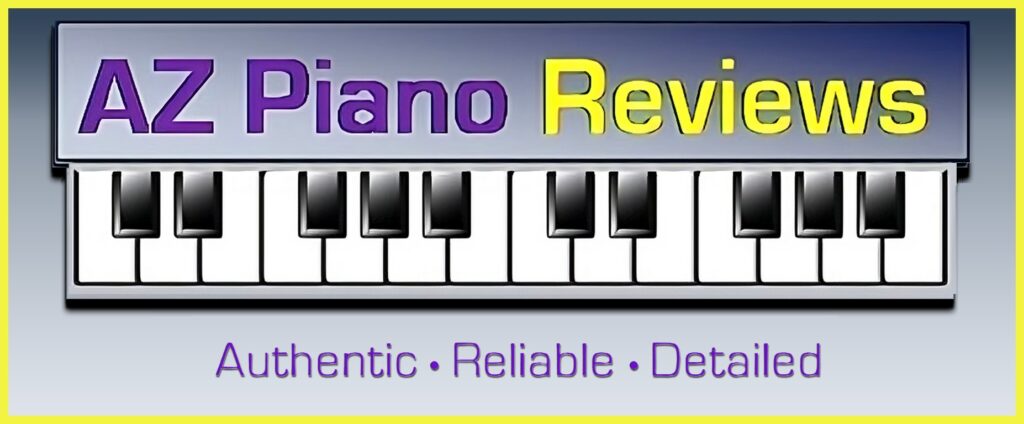



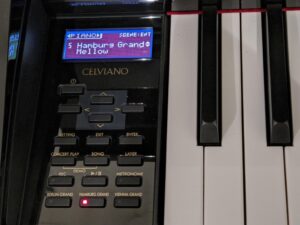
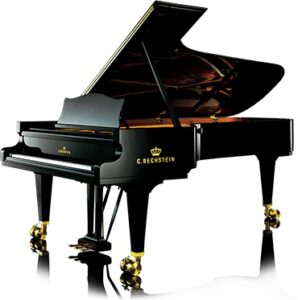
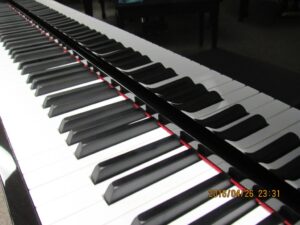
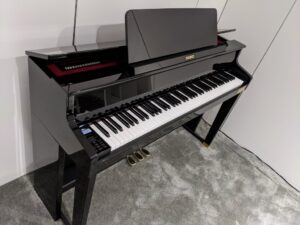
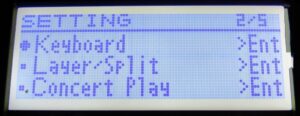
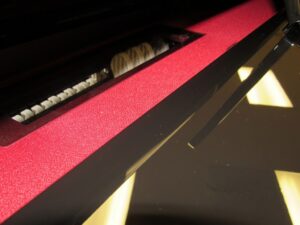
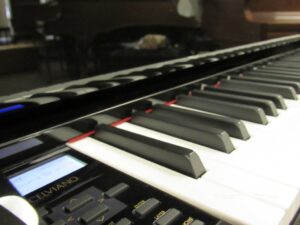
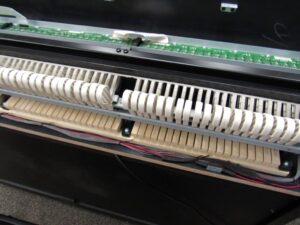



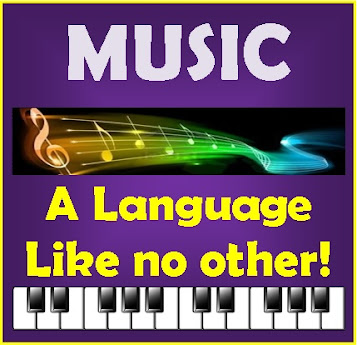

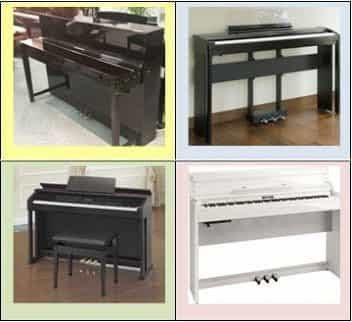


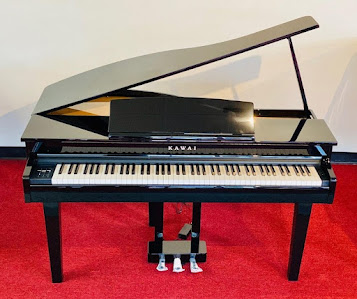
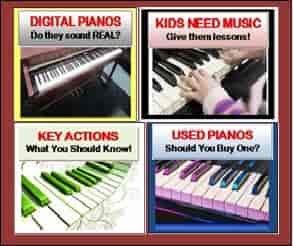
You say that "the GP300…does not sound as realistic as the GP500" — The only differences I've read about on various piano forums are the polished ebony cabinet and the "scene" feature on the GP500 (which can in fact be replicated on the GP300, albeit with some manual tweaking of settings). In looking at the specs you posted, it appears that the GP300 lacks "Hardware resonator" (?) "Open string resonance", "Aliquot resonance", and "Key on/off action noise". Otherwise, the two models have the same sound engine/amp/speakers. Is the sound yet that different? Why would that be?
I think it might be because of the open and aliquot string resonances that the 300 does not feature?
^ Tim is right, although there does not seem to be any good reason for the difference in sound quality given the published technical specs. I've played both the 500 and 300 and there is a clear difference in sound quality with the 3 main pianos from the 500 to 300. To my ear, they aren't even in the same league. IMHO the 300 isn't acceptable at all as far as the piano sounds, especially at this price point.
Has anyone played the 400 yet?
I had the chance to play the GP500 next to a NU1, N1 and N2.
(when I say play, I mean press keys, but anyways)
The N2 gives definite vibrations as feedback into the key.
N1 and NU1 do that too, a bit less so.
I didn't feel much in the GP500. Is there a setting that can adjust that, or doesn't this feature exist at all?
Is there a difference in sound between the 400 and the 500?
Is there anywhere in the NY area I can find these yet to play them?
I don't know. Local dealers throughout the US and what pianos they offer is not my specialty. You can call the manufacturer corporate US office and ask them.
Tim, I have the possibility to buy the Roland LX-17, but it seems to me, after reading this review, that this CASIO GP500 is better or at least the quality of the keyborad is better
Since I live in Europe and for some reasons I have not the possibility to try both these pianos, may I ask you which piano do you prefer?
I am a student of conservatory and I have a limited budget
Thanks
I had the same question as Pietro's of April 19 above. Also, does having wood keys raise a maintenance issue that the LX-17 would not have? Also, does the LX-17 sound better than the GP500? Finally, would having external bi amped speakers improve the sound of either or both of the GP500 or LX-17?
A lot of your comparison between the GP500 and the N2 factored in cost as a consideration. Question: if cost were not a consideration at all, which is the better electric piano, GP-500 or N2? and why? Would really appreciate your advice because that's what I'm trying to decide right now and having a hard time.
I am looking forward to reading your point of view of the new Casio GP-510, especially compared to the first GP-500 hybrid grand pianos.
Some people have said that these pianos don't properly sustain notes for long enough
, and don't have enough power for many headphones. I want to like these, the action seems so cool. Any thoughts on that? I would think that the price may drop since they introduced new models (the 510 and 310).
Yes, I would also appreciate hearing the about the difference between the 500, (which i own thanks to you 🙂 and the 510. And whether an upgrade would be worth it.
I also wonder if anyone else finds it annoying that the buttons on the left control panel are not illuminated. Between the relative darkness of the room while playing/performing and the bright light of the music lamp I need to pull out a small flashlight to see any of the control buttons.
Thanks,
Kevin
I checked out GP-310 and 510 in local showroom. In fact the sound on 510 has broader range of dynamic frequency, higher highs and lower lows, so sound comparison wasn't even close. I am very excited for my G-510 delivery sometime this or next week!!
Hello
I would also like to hear about the difference between the 500 and the 510 please. Thank you so much for these impeccable reviews. After reading them you have no questions left and a good sense of what the specificities of each models are.
This is by far the most comprehensive review of Casio GP-510 and GP-310 series on the internet. Thank you for such a fair review of Casio's effort to challenge other top competitors in the hybrid-piano category. I'm now seriously considering buying either Casio GP-310 or GP-510 since, for me, it's the action that matters the most. It would be a serious investment for a beginner but I think Casio's hybrid are the best value-packed products in this price point.
Hi Tim! How do you compare the gp 510 to clp 775? Here in Brazil both has a similar price. How would you buy? 😅
This or Kawai’s CA501?
This is a good question. The key action on the Casio GP models is impressive and many people like it. It is a firmer/heavier key action than the Kawai model and some people enjoy the lighter, fast action keys on the Kawai. Both Casio and Kawai have a similar internal speaker system with 100 watts of power…but Kawai has a surround sound system with speakers coming out of the top of the piano whereas Casio lid opens up a bit. I really like the Kawai piano sampling technology & choices. As far as the digital technology with the cool “bells & whistles,” Kawai is far ahead of Casio is those ways in my opinion. Either model would be a good choice. Just depends on what you want to do with your music and your focus and experience with piano playing
Hi Tim,
I have my piano in a small/medium room and am worried that the loudness of the GP310 on at least a half volume is going to cause too much resonance and hence muddiness of the sound through the speakers. Do you find this so, compared to the Kawai CA701/901? I currently play the Yamaha CLP745 and find that even on half volume, the sound is sometimes quite overwhelming. But when I turned down the volume further, the piano sound seems muted and changes in quality. Thank you!
Thank you for the very detailed review of the GP series. This is the best information that I have found on the Internet. After all, I bought the GP-510. It works great in the past week and I’m more than satisfied. The reason is that its action is absolutely much better than the other options in this price range.
Previously I have considered Yamaha’s CLP 745/775. The reason I went away from it is because my fingers have a bumpy feeling when pressing down the keys. It’s also a bit heavier than I wanted.
Then I considered Kawai’s CA701. It was my top choice before I found casio’s GP series. the CA series feels lighter than others and should be very easy to play. But the downward travel distance is a bit too far. I have small hands and it makes my fingers easier to touch the edge of other keys.
The GP’s key edges are better rounded than the yamaha/kawai. Overall, it’s travel distance, weight curve, touch and edge’s smoothness are all much better than yamaha/kawai.
Last tip, the GP is really heavy. You’d better have two men to lift it for assembly. You need two strong men to move it upstairs.